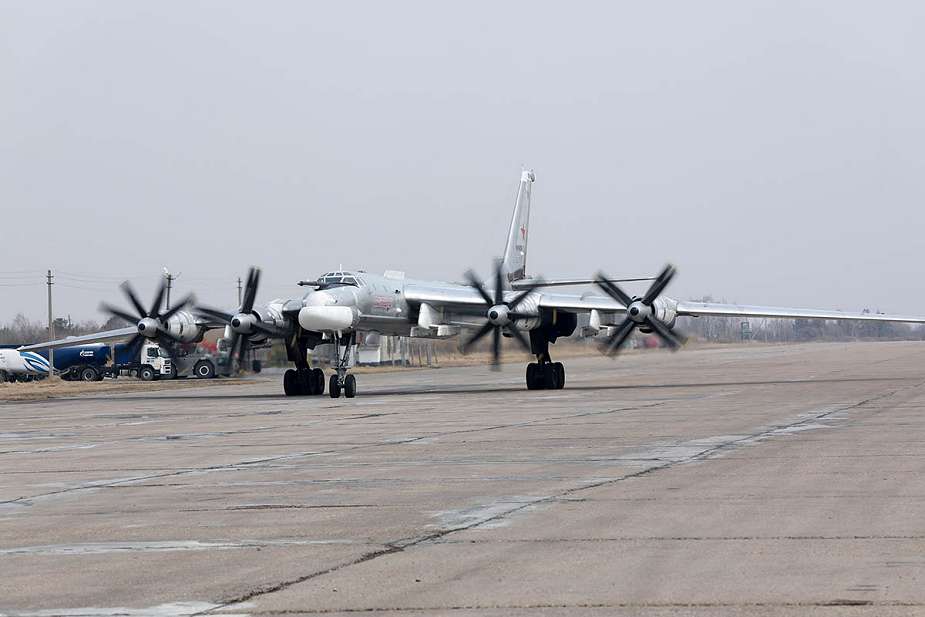On December 10, 2023, British Defence Intelligence reported a significant Russian airstrike conducted on the night of December 7, targeting Kyiv and central Ukraine. This operation marked the first use of heavy bombers, specifically the Tu-95 BEAR H, in such attacks since September 21, 2023. These bombers were deployed to launch a series of cruise missiles, notably the Kh-101, also known by its NATO code designation AS-23A KODIAK. The strike involved at least 16 Air-Launched Cruise Missiles (ALCMs) fired from the Caspian Sea region, a known operational area for these aircraft.
Follow Army Recognition on Google News at this link

Russian Air Force Tu-95MS bomber aircraft can carry up to eight Kh-101 cruise missiles. (Picture source Russian MoD)
The missiles used in the strike were highly likely the AS-23a KODIAK (Kh-101), Russia's premier ALCM, indicating a strategic move by Russia to utilize its stockpiled missiles for the winter campaign. This attack appears to be the beginning of a more intensive Russian campaign aimed at debilitating Ukraine's energy infrastructure. Despite the severity of the assault, Ukrainian air defense systems successfully intercepted most of the missiles. Although there was at least one civilian casualty, the overall damage inflicted was minimal, showcasing the effectiveness of Ukraine's defensive measures.
The Tupolev Tu-95, known by its NATO reporting name BEAR H, is a long-range, large, propeller-driven bomber and missile platform used by the Russian Air Force. Developed during the Cold War, the Tu-95 has been a mainstay of the Soviet and Russian strategic bomber fleet since the 1950s. Its most distinctive feature is its four turboprop engines, each driving contra-rotating propellers, which give it a unique appearance and sound. This design allows the Tu-95 to achieve high subsonic speeds, making it one of the fastest propeller-driven aircraft in operation.
The Russian Tu-95 has a range of about 15,000 kilometers without refueling, enabling it to conduct long-range strategic missions, including carrying nuclear weapons. Over the years, it has undergone various upgrades to enhance its electronic warfare capabilities, avionics, and armaments. The Tu-95 is capable of carrying a variety of weapons, including free-fall bombs and cruise missiles, which makes it a versatile platform in strategic military operations. The first version of the Tu-95 can carry a total of 4 Kh-101 cruise missiles while the Tu-95MS can carry two additional Kh-101 missiles under each of its wings with a total of eight missiles.
The Kh-101, known in NATO as the AS-23a KODIAK, is an advanced Russian air-launched cruise missile (ALCM) designed primarily for the Russian Air Force's strategic bomber fleet, including the Tu-95 BEAR H. This missile is renowned for its long-range, estimated to be up to 2,500 to 3,000 kilometers, and its ability to carry a conventional or nuclear warhead. One of the key features of the Kh-101 is its stealth capabilities; it is designed with a low radar cross-section to evade enemy radar detection and air defenses. The missile is also equipped with advanced guidance and navigation systems, including satellite guidance, inertial navigation, and terrain contour matching, which allow it to maintain high accuracy over long distances. This precision, combined with its stealth characteristics, makes the Kh-101 a formidable tool for strategic, precision strikes against high-value and well-defended targets.
The operational use of the Kh-101 marks a significant advancement in the Russian strategic strike capability. The missile's incorporation into the Russian arsenal represents a shift towards more modern, precision-guided munitions in Russian military doctrine. Its use alongside platforms like the Tu-95 BEAR H highlights Russia's focus on enhancing the reach and effectiveness of its long-range strike capabilities. The Kh-101's ability to carry a variety of warhead types, including nuclear, further underscores its role as a strategic asset within Russia's military framework. The deployment of such advanced weaponry in conflict scenarios, as seen in recent events, demonstrates Russia's willingness to utilize its sophisticated military technology in contemporary warfare settings.
News Russia Ukraine War















